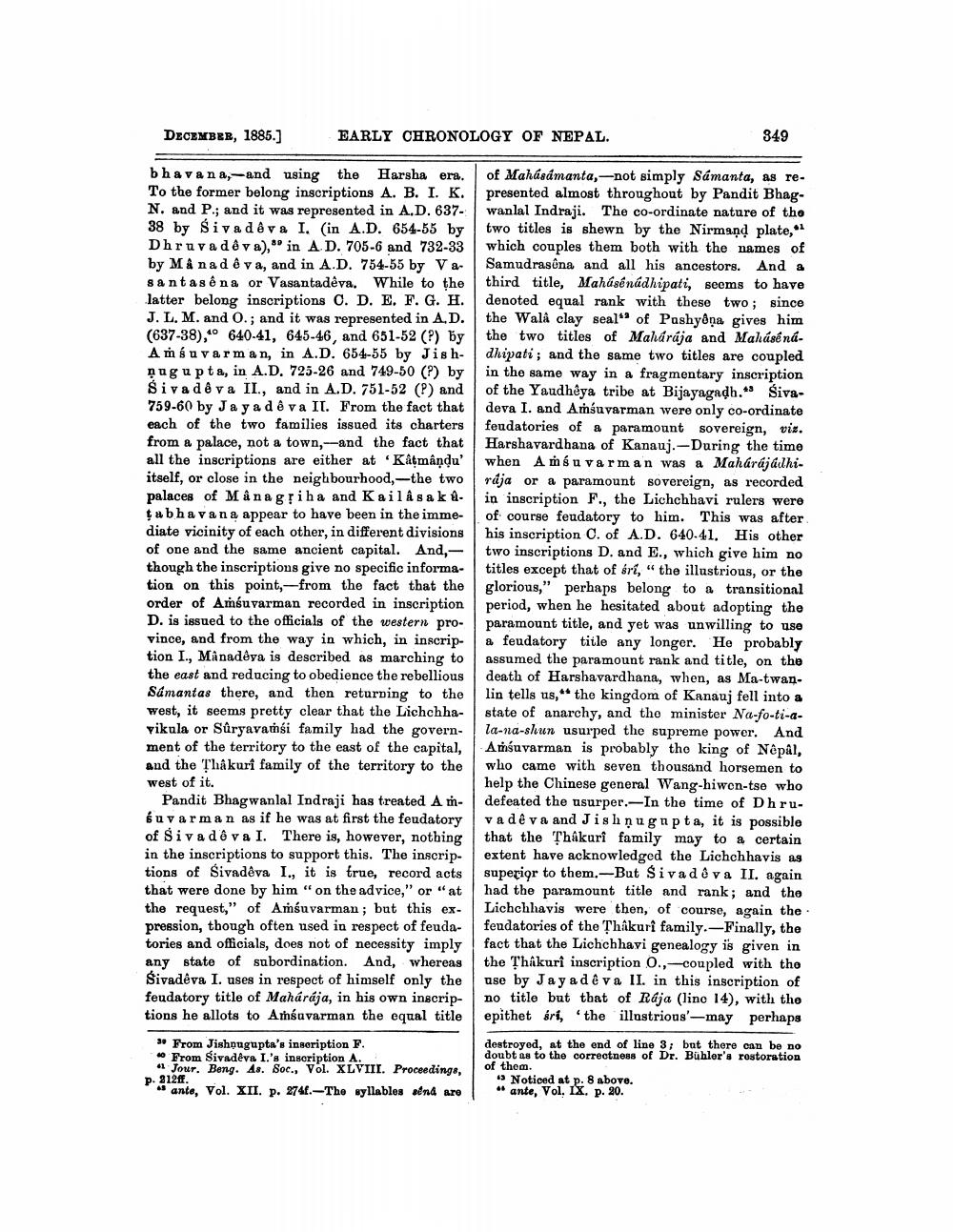________________
DECEMBER, 1885.]
EARLY CHRONOLOGY OF NEPAL.
349
bhavana-and using the Harsha era. To the former belong inscriptions A. B. I. K. N. and P.; and it was represented in A.D. 63738 by Śiva dê va I. (in A.D. 654-55 by Dhruva deva)," in A. D. 705-6 and 732-33 by Månad ê va, and in A.D. 754-55 by V asantas é na or Vasantadêva. While to the latter belong inscriptions C. D. E. F. G. H. J.L.M. and O.; and it was represented in A.D. (637-38), 640-41, 645.46, and 651-52 (?) by Amsu varman, in A.D. 654-55 by Jishņugupta, in A.D. 725-26 and 749-50 (?) by Siva dê va II., and in A.D. 751-52 (P) and 759-60 by Ja ya dê va II. From the fact that each of the two families issued its charters from a palace, not a town,--and the fact that all the inscriptions are either at Kåtmându' itself, or close in the neighbourhood, the two palaces of Managļiha and Kailasak h tabhavana appear to have been in the immediate vicinity of each other, in different divisions of one and the same ancient capital. And, - though the inscriptions give no specific information on this point,-from the fact that the order of Amsuvarman recorded in inscription D. is issued to the officials of the western province, and from the way in which, in inscription I., Manadêya is described as marching to the east and reducing to obedience the rebellious Sámantas there, and then returning to the west, it seems pretty clear that the Lichchhavikula or Suryavamsi family had the government of the territory to the east of the capital, and the Thakuri family of the territory to the west of it.
Pandit Bhagwanlal Indraji has treated ATMsuvarman as if he was at first the feudatory of Sivad ê va I. There is, however, nothing in the inscriptions to support this. The inscriptions of Sivadêva I., it is true, record acts that were done by him "on the advice," or "at the request," of Amsuvarman; but this expression, though often used in respect of feudatories and officials, does not of necessity imply any state of subordination. And, whereas Śivadêva I. uses in respect of himself only the feudatory title of Mahárája, in his own inscriptions he allots to Amśavarman the equal title
of Mahásdmanta,-not simply Sámanta, as represented almost throughout by Pandit Bhagwanlal Indraji. The co-ordinate nature of the two titles is shewn by the Nirmand plate, which couples them both with the names of Samudrasûna and all his ancestors. And a third title, Mahásenádhipati, seems to have denoted equal rank with these two; since the Walk clay seal" of Pashyðņa gives him the two titles of Maharaja and Mahásenádhipati; and the same two titles are coupled in the same way in a fragmentary inscription of the Yaudhéya tribe at Bijayagadh." Sivadeva I. and Ansuvarman were only co-ordinate feudatories of a paramount sovereign, vis. Harshavardhana of Kanauj.-During the time when Amu varman was a Maharajathirdja or a paramount sovereign, as recorded in inscription F., the Lichchhavi rulers were of course feudatory to him. This was after his inscription C. of A.D. 640.41. His other two inscriptions D. and E., which give him no titles except that of śrí,“ the illustrious, or the glorious," perhaps belong to a transitional period, when he hesitated about adopting the paramount title, and yet was unwilling to use a feudatory title any longer. He probably assumed the paramount rank and title, on the death of Harshavardhana, when, as Ma-twanlin tells us," the kingdom of Kanauj fell into a state of anarchy, and the minister Na-fo-ti-ala-na-shun usurped the supreme power. And Amsuvarman is probably the king of Nepal, who came with seven thousand horsemen to help the Chinese general Wang-hiwon-tse who defeated the usurper.-In the time of Dhruvadê va and Jishnugnpta, it is possible that the Thakuri family may to a certain extent have acknowledged the Lichchhavis as superior to them.-But Śivad o va II. again had the paramount title and rank; and the Lichchhavis were then, of course, again the feudatories of the Thakuri family.-Finally, the fact that the Lichchhavi genealogy is given in the Thakuri inscription 0.,-coupled with the use by Jay a dê va II. in this inscription of no title but that of Rája (lino 14), with the epithet ári, the illustrious'-may perhaps
** From Jishnugupta's inscription F.
From Sivadêva I.'s inscription A. "Jour. Beng. As. Soc., Vol. XLVIII. Proceedings, p. 312ff.
* ante, Vol. XII. p. 274.-The syllables and are
destroyed, at the end of line 3; but there can be no doubt as to the correctness of Dr. Bühler's restoration of them.
Noticed at p. 8 above. "ante, Vol. IX. p. 20.




